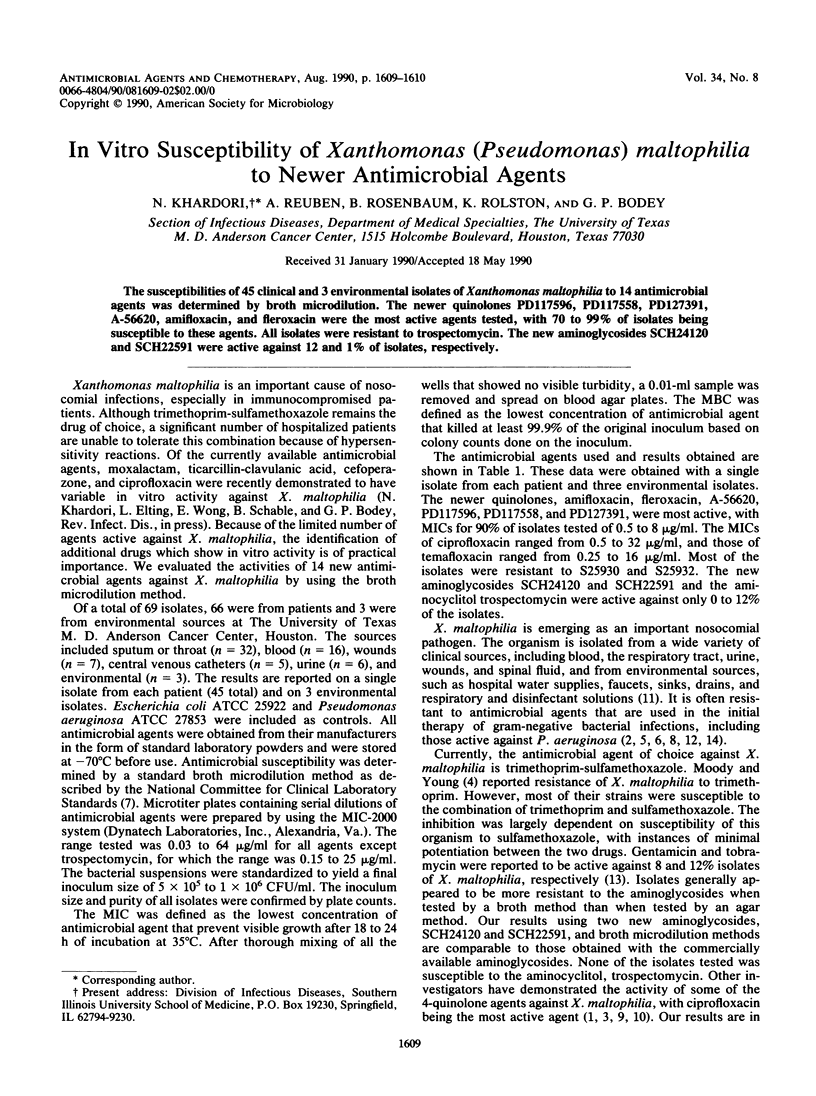Abstract
The susceptibilities of 45 clinical and 3 environmental isolates of Xanthomonas maltophilia to 14 antimicrobial agents was determined by broth microdilution. The newer quinolones PD117596, PD117558, PD127391, A-56620, amifloxacin, and fleroxacin were the most active agents tested, with 70 to 99% of isolates being susceptible to these agents. All isolates were resistant to trospectomycin. The new aminoglycosides SCH24120 and SCH22591 were active against 12 and 1% of isolates, respectively.
Full text
PDF

Selected References
These references are in PubMed. This may not be the complete list of references from this article.
- Barry A. L., Thornsberry C., Jones R. N. In vitro evaluation of A-56619 and A-56620, two new quinolones. Antimicrob Agents Chemother. 1986 Jan;29(1):40–43. doi: 10.1128/aac.29.1.40. [DOI] [PMC free article] [PubMed] [Google Scholar]
- Felegie T. P., Yu V. L., Rumans L. W., Yee R. B. Susceptibility of Pseudomonas maltophilia to antimicrobial agents, singly and in combination. Antimicrob Agents Chemother. 1979 Dec;16(6):833–837. doi: 10.1128/aac.16.6.833. [DOI] [PMC free article] [PubMed] [Google Scholar]
- Moody M. R., Young V. M., Kenton D. M. In vitro antibiotic susceptibility of pseudomonads other than Pseudomonas aeruginosa recovered from cancer patients. Antimicrob Agents Chemother. 1972 Nov;2(5):344–349. doi: 10.1128/aac.2.5.344. [DOI] [PMC free article] [PubMed] [Google Scholar]
- Moody M. R., Young W. M. In vitro susceptibility of Pseudomanas cepacia and Pseudomonas maltophilia to trimethoprim and trimethoprim-sulfamethoxazole. Antimicrob Agents Chemother. 1975 Jun;7(6):836–839. doi: 10.1128/aac.7.6.836. [DOI] [PMC free article] [PubMed] [Google Scholar]
- Morrison A. J., Jr, Hoffmann K. K., Wenzel R. P. Associated mortality and clinical characteristics of nosocomial Pseudomonas maltophilia in a university hospital. J Clin Microbiol. 1986 Jul;24(1):52–55. doi: 10.1128/jcm.24.1.52-55.1986. [DOI] [PMC free article] [PubMed] [Google Scholar]
- Nord C. E., Wadström T., Wretlind B. Synergistic effect of combinations of sulfamethoxazole, trimethoprim, and colistin against Pseudomonas maltophilia and Pseudomonas cepacia. Antimicrob Agents Chemother. 1974 Oct;6(4):521–523. doi: 10.1128/aac.6.4.521. [DOI] [PMC free article] [PubMed] [Google Scholar]
- Rolston K. V., Anaissie E. A., Bodey G. P. In-vitro susceptibility of Pseudomonas species to fifteen antimicrobial agents. J Antimicrob Chemother. 1987 Feb;19(2):193–196. doi: 10.1093/jac/19.2.193. [DOI] [PubMed] [Google Scholar]
- Rolston K., Ho D. H., LeBlanc B., Bodey G. P. In vitro activity of fleroxacin (Ro23-6240), a new fluorinated 4-quinolone against isolates from cancer patients. Chemotherapy. 1988;34(6):448–454. doi: 10.1159/000238607. [DOI] [PubMed] [Google Scholar]
- Schable B., Rhoden D. L., Hugh R., Weaver R. E., Khardori N., Smith P. B., Bodey G. P., Anderson R. L. Serological classification of Xanthomonas maltophilia (Pseudomonas maltophilia) based on heat-stable O antigens. J Clin Microbiol. 1989 May;27(5):1011–1014. doi: 10.1128/jcm.27.5.1011-1014.1989. [DOI] [PMC free article] [PubMed] [Google Scholar]
- Tilton R. C., Steingrimsson O., Ryan R. W. Susceptibilities of Pseudomonas species to tetracycline, minocycline, gentamicin, and tobramycin. Am J Clin Pathol. 1978 Apr;69(4):410–413. doi: 10.1093/ajcp/69.4.410. [DOI] [PubMed] [Google Scholar]
- Zuravleff J. J., Yu V. L. Infections caused by Pseudomonas maltophilia with emphasis on bacteremia: case reports and a review of the literature. Rev Infect Dis. 1982 Nov-Dec;4(6):1236–1246. doi: 10.1093/clinids/4.6.1236. [DOI] [PubMed] [Google Scholar]


